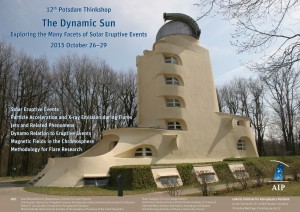Solar Observations with LOFAR
Christian Vocks (Leibniz-Institut für Astrophysik Potsdam (AIP))
Abstract. LOFAR is a novel radio interferometer consisting of a central core near Exloo in the Netherlands, remote stations in the Netherlands, and international stations. It observes in two frequency bands, the low band of 10 – 90 MHz, and the high band of 110 – 250 MHz. The Key Science Project “Solar Physics and Space Weather with LOFAR” aims at observing the Sun with LOFAR. Solar radio radiation in the low and high band emanates from the upper and middle corona, respectively. The solar corona is not a simple layer with barometric density profile, but highly structured due to coronal magnetic fields. The density of the coronal plasma can be estimated by several means, e.g. coronograph data or radio occultation measurements of spacecraft signals. But they leave a gap in the high corona, at a solar distance of a few solar radii. This region is of special interest, since it is where the transition from a hydrostatic corona to the supersonic solar wind is located. If the Sun is observed at a given radio frequency, then the corona becomes opaque below the density level where that frequency corresponds to the local plasma frequency. Since the refractive index of the coronal plasma approaches zero there, refraction effects also need to be considered. I will present LOFAR observations of the quiet Sun at different low-band frequencies, and show how a coronal density model can be derived from observed intensity profiles.
Contributed Talk

Write a comment Close comment form